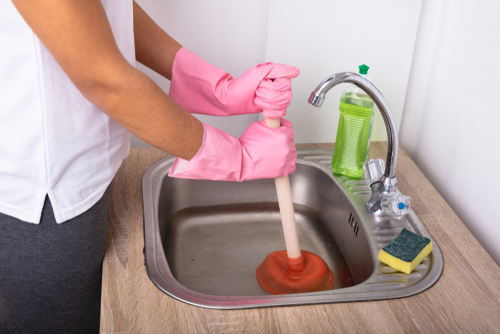Effective Plungers and Drain Cleaner Use: Essential Tips
Effective Plungers and Drain Cleaner Use: Essential Tips
Blog Article
Everyone seems to have their own individual perception about Tips on How to Effectively Use a Plunger.

Introduction
Correct upkeep of family drains is important for preventing obstructions and making sure smooth water flow. Among the secret tools in every home owner's toolkit is the bettor, alongside numerous drain cleansers created to tackle persistent clogs properly. This short article discovers exactly how to make use of plungers and drainpipe cleaners successfully to maintain your drains moving freely.
Section 1: Understanding Plungers
Sorts of Plungers
There are numerous sorts of plungers available, each created for different kinds of drains and obstructs. One of the most common kinds consist of mug plungers, flange plungers, and accordion bettors.
Exactly How Plungers Job
Plungers work with the concept of producing stress and suction to remove clogs. When properly applied over a drainpipe, they produce a vacuum cleaner that can pull out particles or break up obstructions.
Choosing the Right Plunger
Picking the right plunger relies on the type of drain and the nature of the obstruction. Cup plungers are excellent for sinks and tubs, while flange plungers are better fit for commodes due to their design.
Typical Errors with Bettors
Staying clear of these blunders ensures effective plunging: improper seal around the drain, insufficient pressure, and not clearing bordering debris.
Area 2: Utilizing Plungers Effectively
Prep work
Before diving, ensure the bettor covers the drain totally and creates a tight seal. Clear any kind of visible particles around the drain opening.
Technique
Begin with gentle diving movements to construct suction. Boost stress progressively, using a consistent rhythm. Repeat as required till the drain clears.
Troubleshooting Tips
If plunging does not work, try changing the seal, applying petroleum jelly for a better seal, or using a various sort of bettor.
Section 3: Understanding Drainpipe Cleansers
Types of Drainpipe Cleansers
Drain cleansers can be chemical or enzymatic. Chemical cleansers utilize strong chemicals to liquify clogs, while chemical cleaners make use of natural enzymes to break down raw material.
Exactly How Drainpipe Cleaners Job
Chemical cleaners react with obstructions to dissolve them, while chemical cleaners break down organic products like hair and oil without harming pipelines.
Safety and security Considerations
Always put on gloves and eye protection when making use of chemical drain cleansers. Make sure sufficient air flow and comply with manufacturer guidelines thoroughly.
Eco-Friendly Alternatives
Consider utilizing vinegar and baking soda or enzyme-based cleansers for environment-friendly options that are much safer for pipelines and the environment.
Area 4: Making Use Of Drain Cleansers Properly
Application Techniques
Pour chemical cleansers straight into the drain opening. Enable them to benefit the advised time before flushing with hot water. Chemical cleansers need to sit overnight.
Safety measures
Stay clear of blending various sorts of cleaners, as this can create hazardous fumes. Never ever make use of chemical cleansers combined with a bettor, as spilling can take place.
Taking Care Of Persistent Blockages
For consistent blockages, think about using a plumbing serpent or calling an expert plumber to stop damage to pipes.
Final thought
To conclude, recognizing just how to use plungers and drainpipe cleansers efficiently is necessary for maintaining healthy plumbing systems. By selecting the right devices and strategies, homeowners can tackle minor clogs and prevent major plumbing concerns down the line.
How to Use a Plunger to Unclog a Drain
The humble plunger is a simple yet effective tool for breaking clogs in sinks, tubs and toilets. This handy tool is easy to use. You can make the most of its power if you understand how it works. Ready to dive in? Here’s what you need to know.
Safety First!
Never use a plunger with drain chemicals. Water will splash as you work, and the chemicals can spatter, burning skin and eyes. It’s a good idea to use rubber gloves and wear safety goggles when you work on a clog.
Choose the Right Tool for the Job
Plungers come in two different styles. Sinks, bathtubs and showers require a cup plunger. Like its name suggests, the rubber end is shaped like a cup. Use a flange plunger on toilets. These plungers have a rubber funnel extending from the cup. A plunger needs to be big enough to cover the drain.
Ready, Set, Plunge!
Coat the rim: Coat the plunger rim with petroleum jelly. This helps make a better seal. Block outlets: Hold a wet rag over nearby outlets such as the overflow vent or the drain in a second sink. Release air: Insert the plunger at an angle into the water. Water will displace air in the cup. A water-filled cup is more forceful than one filled with air. Keep the plunger upright: Hold the plunger perpendicular to the drain. Use fast, forceful strokes, but make the first stroke gentle. The first stroke can create a splash if the cup still contains air. Thrust the plunger 15 to 20 times. Snap off the plunger: The final stroke should be a strong upward motion that ends when the plunger snaps off the drain. Repeat the process: you may need to repeat this sequence several times. When the water drains away, your work is done. High-five! https://plumbernw.com/blog/how-to-use-a-plunger-to-unclog-a-drain/

I was made aware of that editorial on A Guide to Plungers (and How to Use Them) from an associate on a different site. Are you aware of somebody else who is very much interested in the topic? Why not promote it. Thanks so much for taking the time to read it.
Call Today Report this page